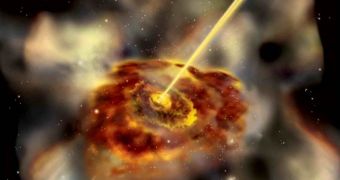The Theory of General Relativity predicts that objects of great mass - such as stars, neutron stars, black holes and so on - have the ability of severely warping the fabric of space-time due to their powerful gravitational pull. The prediction was first verified in 1919, when Arthur Eddington allegedly detected such warps in the fabric of the universe on the orbit of Mercury, the closest planet to the Sun. Now, researchers claim to have evidence of space-time warping around possibly one of the most massive object in the universe.
OJ287 is a quasi stellar object, a quasar with a central black hole weighing a stunning 18 billion times more than our Sun. It is the most massive object in the universe known to this date. Black holes in general have gravitational fields so powerful that the fabric of space-time is warped so severely that it basically curves upon itself.
"People refer to the concept of black holes all the time, but strictly speaking, one first has to prove that general relativity holds in strong gravitational fields before we can be sure that black holes exist," said Mauri Valtonen from the Tuorla Observatory, leader of the study.
Second black hole
OJ287 is located in a distant galactic core and forms a binary system with a second black hole, about 200 times less massive, which is also the central object of the binary. The system emits a powerful electromagnetic burst in the optical spectrum once every 12 years, because the lighter black hole plows through the accretion disk of OJ287 twice every orbit, thus emitting a great deal of energy as the matter is pulled towards the singularity. Valtonen first suggested this process exactly two decades ago.
By creating a model of the system, Tuorla Observatory researchers not only predicted how the binary behaved and when the next burst would take place, but also put a base to testing Einstein's Theory of General Relativity in the vicinity of supermassive black holes. The problem was though that the time of the next burst could only be estimated with a margin of error of a couple of weeks, which is inconclusive to measuring general relativistic effects.
Nevertheless, Valtonen, with the help of his colleagues, succeeded last year to increase the accuracy of their model to a point where they could predict the time of the next optical burst within an error of one or two days, thus establishing that the most likely date is 13 September 2007.
Predictions are confirmed
Indeed, the bright burst of light came on schedule, confirming that the space-time distortions produced by the powerful gravitational pull of the largest of the two black holes produces a precession rate of 39 degrees per period in the orbit of the second black hole. The precession distortion produced by the Sun on the orbit of Mercury, for example, is just about 0.1 degrees per century.
Although gravitational waves have not been either confirmed or infirmed for the time being, the team also predicts that the binary is loosing energy by emitting such radiation. If energy would not be lost through this process, the predicted outburst would have actually taken place 20 days later.

 14 DAY TRIAL //
14 DAY TRIAL //